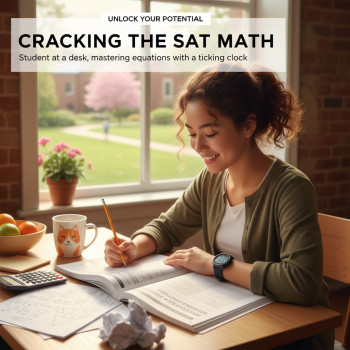Finding the Sweet Spot: Support vs. Independence in Digital SAT Prep
Preparing for the Digital SAT is more than memorizing formulas or drilling practice tests. It’s a delicate partnership between students and the adults who care about them — parents, guardians, teachers, and sometimes tutors. Done well, that partnership helps students build skills, confidence, and the independence they’ll need not only for test day but for college and beyond.
This guide is for students who want to take control of their practice and parents who want their child to succeed without micromanaging. We’ll cover practical routines, emotional coaching, tools and technology, realistic timelines, and sample plans. You’ll find quick-check lists for parents, study strategies for students, and a sample progress table so everyone can see what success looks like.

Why balance matters: independence builds skills, support builds momentum
There’s a reason educators emphasize both soft skills and subject knowledge. The SAT measures reasoning, vocabulary in context, and problem-solving under time constraints — abilities that flourish when a student learns to take ownership. But independence doesn’t appear overnight. Support provides scaffolding: accountability, emotional encouragement, resources, and a safe space to ask questions.
Think of it like learning to ride a bike. Parents start with training wheels and a guiding hand. As the student gains balance, the hand loosens. Eventually the rider pedals confidently alone. The SAT journey follows the same arc: guided practice → growing autonomy → confident performance.
Key principles to keep in mind
- Start with shared goals, not rigid expectations. Pick target scores based on chosen colleges and realistic timelines.
- Focus on processes (study habits, review techniques) more than single outcomes (one test score).
- Support should be conditional and fading: present early, absent when independence grows.
- Use data, but don’t let it rule. Practice results should inform the plan, not crush motivation.
- Quality beats quantity: deliberate practice with feedback is more effective than hours of passive review.
Roles and responsibilities: who does what?
Clear roles reduce friction. Below is a practical split of responsibilities that helps both students and parents understand where support is most useful and when to step back.
Student responsibilities
- Create and follow a study plan (with initial input from a parent or tutor if needed).
- Complete scheduled practice tests and targeted practice sessions.
- Track mistakes in a dedicated notebook or digital log and review them weekly.
- Ask for clarification when stuck, but try problem-solving first (use available resources: official practice, Khan Academy, Bluebook practice tests).
- Practice test-day routines: timing, device familiarity, and stress management techniques.
Parent responsibilities
- Help set realistic timelines and a target score based on college goals and the student’s baseline.
- Create a supportive environment: quiet workspace, healthy routines (sleep, food, exercise).
- Provide accountability through regular check-ins—short, supportive conversations rather than daily monitoring.
- Help access resources like official College Board practice tools, the Bluebook app, or personalized tutoring when needed.
- Celebrate progress and model stress-management—your tone matters.
Practical routines that promote independence
Young people thrive on habit. When studying becomes a routine, independence grows organically. Below are sample routines for different phases of prep: beginning (exploration), middle (skill building), and final (test readiness).
Beginning phase (Weeks 1–4): explore and baseline
- Take one official full-length practice test on Bluebook to set a baseline.
- Identify patterns: timing, content areas, question types that are hardest.
- Establish a 30–60 minute daily study block focused on fundamentals (vocab-in-context, algebra review, passage reading strategies).
- Parents help by setting a predictable study window and removing distractions during that time.
Middle phase (Weeks 5–16): build skills and feedback loops
- Alternate full-length practice tests (every 2 weeks) with targeted practice sessions using official adaptive materials.
- Maintain an error log. Student reviews mistakes and writes one actionable step for improvement per error.
- Schedule mid-week check-ins to discuss tricky problems—not to grade but to coach problem-solving strategies.
- Consider 1-on-1 tutoring for focused weaknesses. Personalized tutoring can accelerate progress by tailoring study plans and giving targeted explanations.
Final phase (Weeks 17–24): simulate test conditions and taper
- Take full-length tests weekly in a test-like environment: device, time blocks, permitted breaks.
- Practice pacing strategies: when to skip, how to mentally reset after a difficult passage.
- Reduce total study time in the week before the test to avoid burnout; focus on light review, sleep, and confidence-building activities.
How tutors and technology fit into the balance
Tutors and digital tools can be powerful when used to promote independence rather than replacing it. Think of tutors as coaches who scaffold skills: they teach, model thinking, and gradually hand responsibility back to the student.
What to expect from high-impact tutoring
- Personalized study plans based on diagnostic tests.
- Targeted lessons on persistent weaknesses (e.g., algebraic structure, evidence-based reading).
- Practice with feedback: tutors correct misconceptions and teach how to learn from mistakes.
- Homework plans that students complete independently, then review with the tutor.
For many families, periodic 1-on-1 tutoring sessions paired with independent practice are the most effective mix. Tutors can also provide AI-driven insights into pacing and common error types—helpful when those insights are used to design focused practice rather than to overload the student.
For example, Sparkl’s personalized tutoring approach combines expert tutors, tailored study plans, and AI-driven insights to diagnose weak spots and recommend targeted practice. When used sparingly and purposefully, this model helps students learn how to study smarter—not just longer.
Sample weekly schedule: a balanced plan for students
Here’s a flexible template you can adapt. The goal: consistent small wins, not marathon sessions.
| Day | Time | Focus | Notes |
|---|---|---|---|
| Monday | 45–60 min | Math targeted practice (weak topic) | Use error log; try 10 mixed practice problems |
| Tuesday | 30–45 min | Reading strategy & passage practice | One timed passage; review answers |
| Wednesday | 45–60 min | Writing & language drills | Focus on sentence structure and transitions |
| Thursday | 30–45 min | Vocabulary-in-context + quick math review | Flashcards or spaced repetition app |
| Friday | Optional 30 min | Reflection & error-log review | Write three takeaways from the week |
| Saturday | 2–4 hours | Full-length practice or two sections timed | Simulate test-day conditions every other week |
| Sunday | Rest or light review | Mindset and relaxation | Sleep, light reading, exercise |
Concrete tools and resources to promote independence
Use official and reliable tools to structure practice. These help the student take charge and keep parents informed without hovering.
- Official practice tests and the Bluebook app for digital practice under test conditions.
- Adaptive practice platforms that create individualized practice routines based on performance.
- An error log (paper or digital) where the student records mistakes, why they happened, and the corrective step.
- Short, focused video lessons for concept review (5–10 minutes) to encourage quick self-help before asking for help.
How parents can use tools without micromanaging
- Ask to see the error log weekly. Ask one question: “What did you learn this week?”
- Encourage the student to set and revise their own weekly goals based on practice data.
- Offer help finding resources, booking a tutor session, or creating a quiet workspace rather than directing every study minute.
Emotional coaching: language that helps
Words matter. How you speak about the SAT — as a milestone instead of a verdict — shapes a student’s motivation. Here are phrases that help and phrases to avoid.
Helpful phrases
- “Tell me what you want to improve this week.”
- “What strategy helped you most on that passage?”
- “Let’s plan one step forward rather than solve everything today.”
- “I’m proud of the effort you put in.”
Unhelpful phrases
- “You have to get X score.”
- “Why did you miss that question?” (better: “What was confusing about it?”)
- “You’re wasting time.”
Common roadblocks and how to fix them
Everyone hits bumps. Below are common problems and straightforward fixes.
Procrastination
- Fix: Break study into 25–45 minute focused blocks (Pomodoro). Celebrate completion of one block.
Overreliance on help
- Fix: Require one independent attempt before seeking help. Tutors can ask the student to show an attempt before explaining.
Test anxiety
- Fix: Regular low-stakes practice under timed conditions, breathing exercises, and simulating test day to reduce fear of the unknown.
When to bring in targeted professional help
Some issues benefit greatly from expert intervention. Consider a tutor or structured program when:
- Score plateaus despite consistent practice.
- Foundational gaps (e.g., algebra basics) block progress.
- Student responds well to one-on-one feedback and needs structured accountability.
When you hire help, look for a tutor who emphasizes metacognitive skills: teaching the student how to learn. Sparkl’s approach of combining expert tutors with AI-driven insights and tailored study plans can be a good fit for students who need concise, data-driven direction while maintaining ownership of their practice.
Measuring progress: meaningful metrics
Score alone doesn’t tell the whole story. Use layered metrics to evaluate growth.
- Raw practice scores and scaled scores from official tests.
- Error type distribution: time management vs. content knowledge vs. careless mistakes.
- Consistency: improvement across multiple practice tests, not a single outlier.
- Self-efficacy: student’s confidence in timing and strategies.
Sample progress checklist for a 6-month plan
| Month | Student Goal | Parent Role | Measure of Progress |
|---|---|---|---|
| 1 | Baseline test; identify 3 weak areas | Help set study window; remove distractions | Diagnostic score and error log started |
| 2–3 | Targeted practice on weak areas; weekly drills | Weekly check-ins, praise progress | Two-point improvement on practice sections |
| 4–5 | Full-length practice under test conditions; pacing | Arrange quiet Saturday tests; review logistics | Consistent scores and improved pacing |
| 6 | Final polish; taper study time; rest | Emotional support; manage test-day needs | Confidence and planned test-day routine |
Putting it all together: a closing roadmap
Balancing support and independence is an ongoing conversation, not a one-time decision. Start with a shared plan, build routines that give the student control, use tutors and tech to provide targeted feedback, and shift toward less hands-on support as confidence grows. Celebrate small wins and keep the focus on learning how to learn. The Digital SAT is a milestone, not the whole story.
Practical first steps for this week:
- Take one official practice test to set a baseline.
- Create an error log template (three columns: question, why I missed it, next step).
- Set one achievable goal: for example, “Improve pacing on reading passages” or “Master quadratic manipulation.”
- If helpful, schedule an introductory session with a tutor to create a short personalized plan—look for tutors who emphasize study skills and independence.

Final encouragement
Parents: your support is a steady lighthouse—visible but not steering. Students: your independence is the engine—nurture it with discipline and curiosity. Together, you can transform SAT prep from a stressful hurdle into a growth opportunity that builds skills far beyond the score report.
When you focus on balance, small consistent actions add up. With a clear plan, honest communication, and the right mix of support and autonomy, the Digital SAT becomes one more milestone on the path to college—and a chance to learn how to learn for life.
Good luck, and remember: progress is rarely linear, but it’s always possible.















No Comments
Leave a comment Cancel